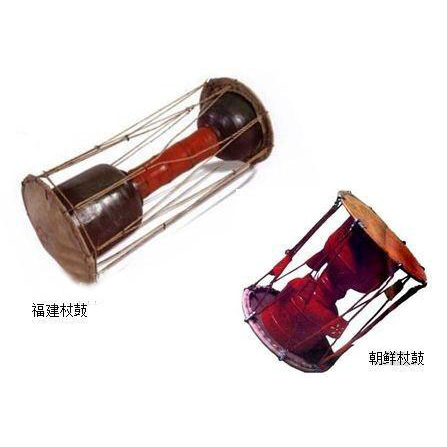How the stick drum is played
202 views · Organized by 迷雾风暴 on 2022-03-14
The stick drum is divided into Fujian stick drum and Korean stick drum. Fujian zhanggu and Korean zhanggu are both ancient Chinese slender-waisted drum instruments. The two are similar in shape, but also different.

Fujian stick drum
When used for percussion performance, hold the waist of the drum with the left hand or put it on the back of the body, put the five fingers of the right hand together, and slap the drum face with the first and second sections of the fingers. In the music of Fuzhou Juban, it is mostly in harmony with the rhythm of the melody, hitting characteristic rhythm patterns such as XXO and X-X. The Fujian stick encouragement incorporates the enthusiastic and unrestrained movements of the lion, which is chic and powerful, and is unique.Korean stick drum
When playing, hang the drum horizontally in front of the abdomen or place it on a wooden frame, hold the iron ring with the thumb of the left hand, the other four fingers can tap the drum surface with one finger or slap together, and the right hand holds the bamboo stick to tap the drum surface. After people's continuous exploration and sorting, the performance skills are extremely rich. There are four kinds of playing methods on the tambourine surface, such as single drum, single flower, double flower, and smothered drum. Forty kinds. Often used for solo, instrumental ensemble or for solo, dance accompaniment. The stick drum is one of the main solo instruments among the Korean folk. When it is played in unison or ensemble with Korean folk instruments such as the tube flute and the xiaoji, it is the lead instrument. Therefore, there is a folk saying that "the first is a famous drummer, and the second is a famous singer." It can be seen that the stick drum plays an important role in the folk band. When people see Korean girls dancing with a small stick drum hanging across their belly, this performance is the famous Korean "Chang Drum". The stick drum is not only an accompaniment instrument for dance, but also a dance prop. The sonorous drum sound is accompanied by a vigorous dance, which is very moving. A slightly larger stick drum is placed on a wooden frame to participate in instrumental ensembles or to accompany vocal music (such as solo singing, Gaya piano) and dance, and is often used to express brisk and joyful emotions. Under the percussion of the skilled player, the two different sounds are interlaced, and the two different tones are flickering, sometimes light and sometimes heavy, and the sound is exceptionally clear and bright, sometimes like a pearl falling on a jade plate, ding dong. The sound, sometimes like a lotus leaf moving by water, is amazing. It expresses complex and delicate thoughts and feelings with a unique and rich musical language, with a distinct Korean style and strong local color.Involving musical instruments
The stick drum (pinyin: zhàng gǔ), the Korean mixed percussion instrument, also known as the long drum, is called bu in Korean. Popular in Liaoning, Jilin, Heilongjiang, Inner Mongolia, Hebei and other provinces, especially in Yanbian Korean Autonomous Prefecture in Jilin Province.
 渝公网安备 50010702504639号
渝公网安备 50010702504639号